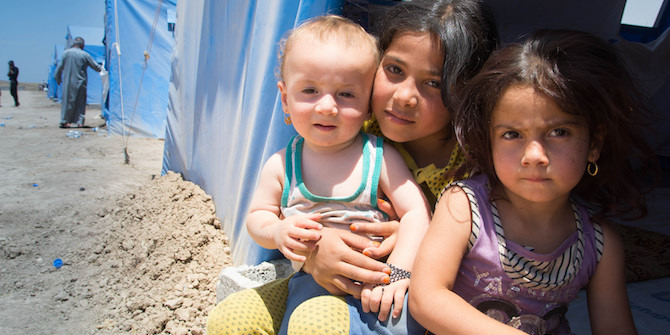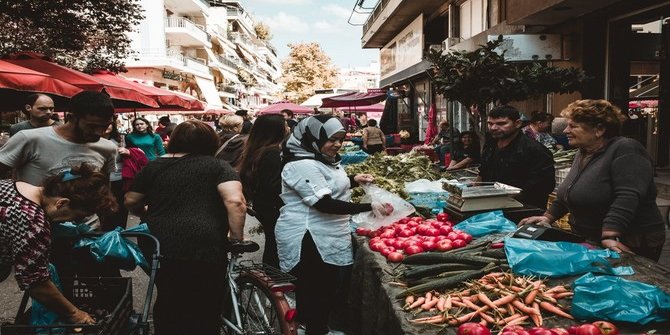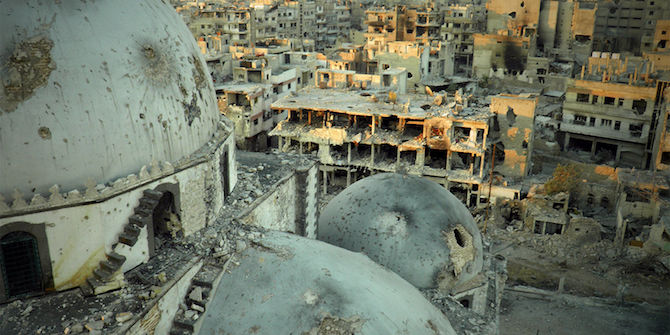by Kyra Luchtenberg

The post-2014 displacement caused by ISIS’ occupation of large parts of Iraq was supposedly more sudden, and much less organised, than previous instances of mass displacement. It was even presumed to have reversed part of the homogenisation trend observed after the 2006–2008 displacement, during which the UNHCR announced that “return movements are mostly happening to areas which have become ethnically/religiously homogenous [and] returnees mostly return to those [areas] under control of members of their sect.” However, a new trend of homogenisation could be identified in those areas recently retaken from ISIS previously known for their multi-ethnic population, potentially aggravating the level of inter- and intra-communal tensions in northern Iraq.
The return of displaced populations is often interpreted as a sign of peace and stability. It is even argued that it challenges “the root causes of a conflict”. When security improves and people feel safer, the numbers fleeing their homes decrease and some of the displaced return. When there is an upsurge of violence, people leave their homes again. While violence inevitably causes displacement, return mobilisation is not immediately set in motion after areas have been declared safe. Internally Displaced Persons (IDPs) often decide to stay in their area of displacement and postpone their return. This decision is influenced by the level of property damage, the access to basic services, and the prospect of livelihood opportunities in their area of origin. Yet, the decision to return predominantly depends on the security actor in control and the perceived risk of being subjected to reprisal attacks, harassment or discrimination.
At first sight, the current trend of homogenisation is not necessarily along sectarian lines, but rather relates to the moment of displacement. IDPs who fled before ISIS took control of their area are victims in the narrative, while those who lived under the control of ISIS are considered hostile. In particular, IDPs with family ties to suspected ISIS-affiliates or sympathisers have been subjected to discriminatory vetting upon return by state security forces and, at times, their former neighbours. Tensions between and within communities are used by security forces to legitimise restrictions on who may cross and circulate within the provincial borders, despite the questionable legal foundations of such strictures. These restrictions have “exacerbated the vulnerability of IDPs”, subjecting them to administrative pressures and violence at checkpoints and within camps, and have blocked returns in some cases. Recent memories of sectarian violence feed into these divisive practices, indirectly promoting the creation of homogenous areas and justifying collective punishment by civilians themselves.
Meanwhile, the actual and perceived failure of the Iraqi government allows sub-state authorities to take on the role of “protector and provider”, offering returnees safety and basic services in return for their allegiance. A striking example is the response to returnees’ concerns of mines and unexploded IEDs (Improvised Explosive Devices) planted by ISIS in front doors, furniture, fridges, and cans of food. Interviewed IDPs describe how the local police directed them to the Hashd al-Shaabi when asked to remove the unexploded IEDs, yet others accuse the Hashd of destroying or looting their houses. Although this group’s status as a legitimate, state security actor has been questioned, members of the group use their role in the fight against ISIS and “bringing people home” to counter criticism. In this way, displaced communities can become “bargaining chips” to secure political, territorial or economic dominance.
Evidently, the security situation not only depends on the actions and motives of security forces, but also the actions taken by people to protect themselves from the (in)direct consequences. A narrative of armed “self-defence” is increasingly being promoted by local community leaders, encouraging civilians to prepare for a post-ISIS future, in which they no longer rely on the state security forces for protection. In particular, minority groups have been susceptible to this rhetoric, condemning the Iraqi Forces for failing to protect them from ISIS atrocities. This stands to not only increase the legitimacy of sub-state authorities – just in time for the 2018 national and provincial elections – but also aggravate the already highly-fragmented state security apparatus. It also underlines the complexity of the disarmament, demobilisation and reintegration of militias in post ISIS-Iraq.
In the absence of state-initiated reconciliation processes, vetting of returnees is being used to compensate for past atrocities and reduce communal fear. Therefore, beyond the relief assistance needed to reverse the wide-scale property damage and increase access to basic services, communal relations need to be rebuilt, particularly in multi-ethnic areas. Civil society organisations have started initiating peace and reconciliation projects, seeking to guarantee IDPs’ voluntary and safe return. Meanwhile, the international community continues to promote “return” as the most durable solution to displacement in Iraq, dismissing the alternatives of integration within the place of displacement, or resettlement elsewhere in the country. The latent political imperatives of return continue to be ignored, overlooking the role of state security forces and armed groups in steering IDP return processes. Questions as to who will monitor IDP return processes, what kind of assistance returnees will receive, and who will ensure the protection of returnees, remain unanswered.
This is part of the proceedings of a conference on Responses to Displacement in the Middle East, held at the LSE on 30 November 2017. This article is based on insights from field research Kyra Luchtenberg conducted in the Kurdistan Region of Iraq in July 2017. In total, 58 IDPs from different parts of Iraq participated in semi structured interviews and focus groups, sharing their history of displacement and intentions to return.
 Kyra Luchtenberg is a Research Assistant at the LSE Centre for Women, Peace and Security and previously worked at the LSE Middle East Centre. Her research areas include conflict dynamics, forced displacement, transitional justice and collective memory in the Middle East, with a specific focus on Iraq, Syria and Lebanon. She tweets at @KyraLuchtenberg
Kyra Luchtenberg is a Research Assistant at the LSE Centre for Women, Peace and Security and previously worked at the LSE Middle East Centre. Her research areas include conflict dynamics, forced displacement, transitional justice and collective memory in the Middle East, with a specific focus on Iraq, Syria and Lebanon. She tweets at @KyraLuchtenberg
In this series:
- Introduction by Zeynep Kaya
- Going Back or Staying Better: Processes of Return After Displacement due to ISIL by Nesreen Barwari
- Returnees in Syria: Sustainable reintegration and durable solutions or a return to displacement? by Schadi Semnani
- Breaking the Vicious Circle: Exploring Alternatives to Current Responses and Solutions to Internal Displacement in Yemen by Stean Auguste Tshiband
- Iraq after the Islamic State: Displacement, migration and return by Irene Constantini
- Displaced and on the Move Again: Decision-making among IDPs who migrate to Europe by Megan Passey
- Violence, Insecurity and the (Un)making of Rukban Camp by Suraina Pasha
- Between International Influence and Domestic Politics: The case of the refugee control policy towards Syrian refugees in Lebanon by Zad El Hage Sleiman
- Fleeing Home at Home: Internal Displacement in Homs, Syria by Ammar Azzouz and Irit Katz
- A Phenomenological Exploration of the Gendered Vulnerabilities of Internally Displaced Syrians by Jaclynn Robinson
- Chaos and Fear: Governmental strategies to hinder national and international humanitarian responses to internal displacement in Turkey by Eva Jones
- Administrative Violence and Palestinian Displacement in West Bank Area C by Mustafa Fatih Yavuz
- Local Integration in the Context of Protracted Displacement Inside Syria by Simon Verduijn






